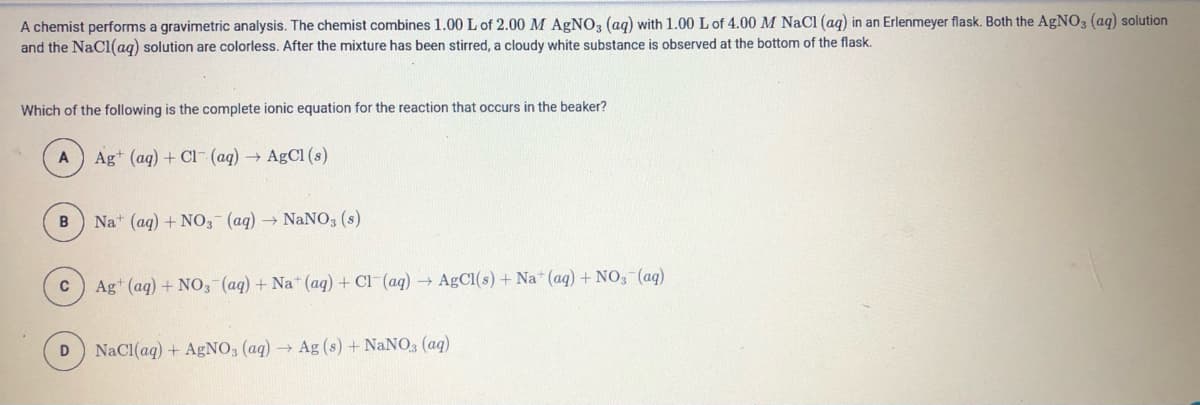and the NaCI(ag) solution are colorless. After the mixture has been stirred, a cloudy white substance is observed at the bottom of the flask. Which of the following is the complete ionic equation for the reaction that occurs in the beaker? A Ag* (ag) + Cl- (aq) AgCl (s) Na (ag) + NO3 (aq)NANO3 (s) Ag (aq) + NO,(aq) + Na (aq) + Cl-(aq) → AgCl(s) + Na (aq) + NO, (aq) NaCl(aq) + AGNO, (aq)Ag (s) + NaNO, (aq)
and the NaCI(ag) solution are colorless. After the mixture has been stirred, a cloudy white substance is observed at the bottom of the flask. Which of the following is the complete ionic equation for the reaction that occurs in the beaker? A Ag* (ag) + Cl- (aq) AgCl (s) Na (ag) + NO3 (aq)NANO3 (s) Ag (aq) + NO,(aq) + Na (aq) + Cl-(aq) → AgCl(s) + Na (aq) + NO, (aq) NaCl(aq) + AGNO, (aq)Ag (s) + NaNO, (aq)
General Chemistry - Standalone book (MindTap Course List)
11th Edition
ISBN:9781305580343
Author:Steven D. Gammon, Ebbing, Darrell Ebbing, Steven D., Darrell; Gammon, Darrell Ebbing; Steven D. Gammon, Darrell D.; Gammon, Ebbing; Steven D. Gammon; Darrell
Publisher:Steven D. Gammon, Ebbing, Darrell Ebbing, Steven D., Darrell; Gammon, Darrell Ebbing; Steven D. Gammon, Darrell D.; Gammon, Ebbing; Steven D. Gammon; Darrell
Chapter4: Chemical Reactions
Section: Chapter Questions
Problem 4.21QP
Related questions
Question
100%

Transcribed Image Text:A chemist performs a gravimetric analysis. The chemist combines 1.00 L of 2.00 M AGNO, (ag) with 1.00 L of 4.00 M NaCl (aq) in an Erlenmeyer flask. Both the AGNO, (aq) solution
and the NaCl(ag) solution are colorless. After the mixture has been stirred, a cloudy white substance is observed at the bottom of the flask.
Which of the following is the complete ionic equation for the reaction that occurs in the beaker?
A
Ag+ (ag) + Cl- (aq) → AgCl (s)
B
Na (aq) + NO3 (aq) → NANO3 (s)
Ag (aq) + NO, (aq) + Na (aq) + Cl-(aq) → AgCl(s) + Na* (aq) + NO, (aq)
NaCl(aq) + AGNO, (aq) Ag (s) + NANO, (aq)
Expert Solution
This question has been solved!
Explore an expertly crafted, step-by-step solution for a thorough understanding of key concepts.
Step by step
Solved in 2 steps with 1 images

Knowledge Booster
Learn more about
Need a deep-dive on the concept behind this application? Look no further. Learn more about this topic, chemistry and related others by exploring similar questions and additional content below.Recommended textbooks for you

General Chemistry - Standalone book (MindTap Cour…
Chemistry
ISBN:
9781305580343
Author:
Steven D. Gammon, Ebbing, Darrell Ebbing, Steven D., Darrell; Gammon, Darrell Ebbing; Steven D. Gammon, Darrell D.; Gammon, Ebbing; Steven D. Gammon; Darrell
Publisher:
Cengage Learning

Chemistry: Principles and Practice
Chemistry
ISBN:
9780534420123
Author:
Daniel L. Reger, Scott R. Goode, David W. Ball, Edward Mercer
Publisher:
Cengage Learning

Chemistry: An Atoms First Approach
Chemistry
ISBN:
9781305079243
Author:
Steven S. Zumdahl, Susan A. Zumdahl
Publisher:
Cengage Learning

General Chemistry - Standalone book (MindTap Cour…
Chemistry
ISBN:
9781305580343
Author:
Steven D. Gammon, Ebbing, Darrell Ebbing, Steven D., Darrell; Gammon, Darrell Ebbing; Steven D. Gammon, Darrell D.; Gammon, Ebbing; Steven D. Gammon; Darrell
Publisher:
Cengage Learning

Chemistry: Principles and Practice
Chemistry
ISBN:
9780534420123
Author:
Daniel L. Reger, Scott R. Goode, David W. Ball, Edward Mercer
Publisher:
Cengage Learning

Chemistry: An Atoms First Approach
Chemistry
ISBN:
9781305079243
Author:
Steven S. Zumdahl, Susan A. Zumdahl
Publisher:
Cengage Learning

Chemistry
Chemistry
ISBN:
9781305957404
Author:
Steven S. Zumdahl, Susan A. Zumdahl, Donald J. DeCoste
Publisher:
Cengage Learning


Chemistry for Engineering Students
Chemistry
ISBN:
9781337398909
Author:
Lawrence S. Brown, Tom Holme
Publisher:
Cengage Learning